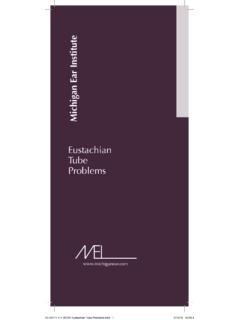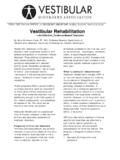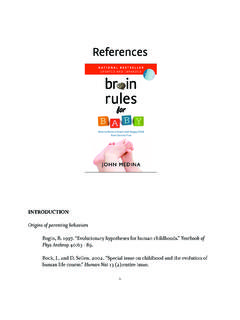Transcription of Airbag Deployment Study - Otologic Injuries Secondary to ...
1 Airbag Deployment Study - Otologic Injuries Secondary to Airbag Deployment Otologic Injuries Secondary to Airbag Deployment William J. McFeely, Jr., Dennis I. Bojrab, Kent G. Davis, Douglas F. Hegyi, From the Michigan Ear Institute and Providence Hospital, Farmington Hills and Southfield, Michigan (Drs. McFeely and Bojrab); Department of Otolaryngology, Wayne State University, Detroit, Michigan (Dr. Davis); Lapeer Medical Center, Lapeer, Michigan (Dr. Hegyi). Presented at the American Academy of Otolaryngology--Head and Neck Surgery Foundation Annual Meeting, San Antonio, Texas, September 13-16, 1998. Address correspondence to: Dennis I. Bojrab, Michigan Ear Institute 27555 Middlebelt Road Farmington Hills, MI 48334 Phone: (248)-476-4622 Fax: (248)-476-7390 ABSTRACT Airbags are clearly successful at mitigating injury severity during a motor vehicle accident (MVA).
2 Deployment unfortunately has introduced new injury-causing mechanisms. A retrospective review of 20 patients who sustained Otologic Injuries resulting from Airbag inflation was conducted. The most common complaints were hearing loss in 17 (85%), and tinnitus in 17 (85%). Objective hearing loss was documented in 21 of 24 (88%) subjectively affected ears; this included unilateral and bilateral sensorineural, unilateral conductive, and mixed hearing losses. Ten patients (50%) experienced disequilibrium. Four subjects (20%) had a tympanic membrane (TM) perforation; each required surgical closure. Ear orientation toward the Airbag was found to be associated with hearing loss (p = .027), aural fullness (p = .039), and TM perforation (p = .0004). A wide variety of Airbag -induced Otologic Injuries occur and may have long-term sequelae. It is important for health care personnel to be aware of these potential problems.
3 INTRODUCTION Federal regulations required that airbags be installed in all passenger cars, vans, pickup trucks and utility vehicles as of September 1, Airbags clearly are successful at decreasing injury severity during a ,3 Based o n all types of crashes, they decrease fatalities by 21-22% for unbelted drivers, and by 9-16% for drivers wearing Airbag Deployment unfortunately has introduced a new spectrum of Injuries ; numerous reports of injury patterns ,7-17 The majority are relatively minor, and usually consist of erythema, abrasions, and contusions to the face, anterior neck, or upper ,16 More serious harm is rare, but there are accounts of life-threatening trauma in the ,10,16 Damage to the eye,7 cervical spine,8,9,16 facial nerve,17 temporomandibular joint,11 facial skeleton,7,8 and upper airway injury15 are of particular importance to the practicing otolaryngologist.
4 Recent reports have documented a total of 13 people with Otologic symptoms of hearing loss, tinnitus and / or ,14,18-22 A number of patients with unusual Otologic findings after Airbag Deployment were recently encountered in our practice. Many of these problems are yet to be described in the literature. The purpose of the present Study is to retrospectively review these patients, as well as to discuss all relevant literature. MATERIALS AND METHODS Patients with Otologic complaints after Airbag Deployment between April 1995 and April 1998 were retrospectively studied. Twenty Airbag subjects were extracted from a total of 109 charts of MVA patients. Eighty-nine patients were excluded due to lack of Airbag Deployment . A retrospective chart review was conducted; a telephone questionnaire was performed to acquire any missing subjective data. Each patient underwent a complete neuro - Otologic examination .
5 Testing was not standardized given the retrospective nature of this Study . Pure tone and speech audiometry was performed post-accident and periodically after initial evaluation in nearly all subjects. Hearing tests completed less than one year before the MVA were retrieved for comparison purposes when possible. Post-accident audiometric testing was divided into two groups based on early (less than one month) and late (more than one month) after the MVA. A four-frequency ( , 1, 2, and 3 kHz) pure tone average (PTA) was calculated in standard fashion for each audiogram. A number of statistical methods were utilized for data analysis. The Fisher s Exact test was used for independence between categorical variables. Differences between groups were tested using the Mann-Whitney Test. The Paired T-Test was used for comparison of audiometric PTA scores. Both affected ears ( , with bilateral involvement) were included in calculations for certain variables when appropriate.
6 Driver inboard (right) ears were considered as oriented towards a deploying passenger side Airbag when overall head positioning was straight ahead. RESULTS Subject demographic and accident information is outlined in Table 1. There were 11 females and 9 males with a mean age of 48 years (range 7 to 75). Nearly all individuals were driving the car, and the driver side Airbag deployed in all accidents studied. Passenger-side Airbag Deployment occurred in 9 of 20 (45%). All patients were wearing seatbelts, though case 4 (a child) was improperly restrained at time of impact. Follow-up averaged 18 months (range 4 to 40). A wide variety of automobiles were involved. All vehicles sustained a frontal or near-frontal impact. Average speed of impact was 42 (range of 5 to 80) miles per hour. No patient sustained a skull-base fracture, or significant closed head injury. History of previous Otologic problems prior to the MVA was obtained; results are listed in Table 2.
7 Three patients underwent surgery previously for chronic ear disease. Each of these subjects had been doing well before the accident with no evidence for active disease or perforation. Mild pre-existing subjective hearing loss was described in 9 of 20 (45%), infrequent tinnitus in 3 (15%), and mild intermittent disequilibrium in 1 (5%). No subjective complaint was felt to be bothersome just prior to the MVA. New onset hearing loss in 17 (85%) and non-pulsatile tinnitus in 17 (85%) were the most common symptoms after Airbag Deployment . These occurred together on a statistically significant basis (p < .0001 by Fisher s Exact Test). Of the 17 with subjective hearing loss, it was unilateral in 10 (59%), bilateral in 7 (41%), and persistent in 13 (76%). Tinnitus was unilateral in 11 (65%), bilateral or non-localized in 6 (35%), and persistent in 9 (53%). Other common complaints in our 20 patients included: disequilibrium in 10 (50%), and aural fullness in 6 (30%).
8 Disequilibrium was temporary in 6 of 10 (60%), persistent in 4 (40%), and delayed in 1 (10%). Aural fullness was associated with occupant head position towards the Airbag (p = .039 by Fisher s Exact Test). Objective hearing loss (drop of at least 10 dB at two frequencies) was documented in 21 of 24 (88%) subjectively affected ears. Of ears with objective hearing loss, the type was sensorineural in 17 (81%), conductive in 2 (10%), and mixed in 2 (10%). High frequencies (> 4 kHz) were most commonly affected, followed by middle (2-4 kHz) and low frequencies (< 2 kHz). Seven subjects underwent a hearing test prior to the MVA. The audiometric configuration grossly changed ( , from normal to flat, or from flat to sloping) in 5 of 9 ears (56%) that had hearing objectively documented before the MVA. The PTA increased significantly after Airbag Deployment in these 9 ears by 10 dB both within the first month as well as one month after the accident.
9 This average change was statistically significant for the early (p < .001 by Paired T-Test), and late (p = .002 by Paired T-Test) time periods. Of all tested variables, increased age (p = .028 by Mann-Whitney Test), and head position toward the Airbag (p = .027 by Fisher s Exact Test) were statistically related to hearing loss. No significant difference was found between post-MVA hearing levels based on time from the MVA (p = .804 by Paired T-Test). Of the 10 patients with dizziness, 4 (40%) had caloric weakness, 2 (20%) were diagnosed with benign paroxysmal positional vertigo (BPPV), and 2 (20%) developed endolymphatic hydrops. Two subjects (20%) had non-specific disequilibrium. Patients with BPPV were treated with a particle-repositioning maneuver. One subject with hydrops presented 2 months after the MVA in a delayed fashion. Medical therapy was effective in controlling hydrops symptoms.
10 Four of the 10 (40%) with dizziness have chronic symptoms resistant to medical and vestibular therapy. Three of 20 (15%) described chronic otalgia. TMJ dysfunction was diagnosed in each, and was bilateral in one. No subject appeared to have this condition before Airbag Deployment . Pain has been mitigated with conservative treatment alone. Unilateral TM perforations were documented in 4 patients (20%). Two had mixed and two had conductive hearing losses. Three had the affected ear directly oriented toward the deploying Airbag in front. The other was a driver who had the right TM perforated after being exposed to dual Airbag inflation, despite a neutral head position. Ear orientation was the only statistically significant related variable for TM perforation (p = .0004 by Fisher s Exact Test). Each patient required a tympanoplasty, and showed hearing improvement postoperatively.







